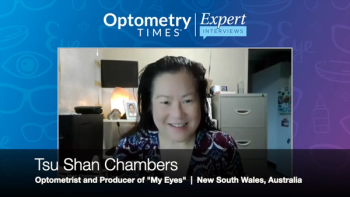
- December digital edition 2021
- Volume 13
- Issue 12
Careful evaluation of ophthalmic diagnostics in retinal cases
Evolving techniques may offer better long-term outcomes for patients
A 20-year-old man presented to the clinic urgently complaining of a persistent afterimage involving his right eye secondary to a laser exposure that had occurred approximately 20 minutes earlier. The symptom had not dissipated in the interval since the incident.
According to the patient, he and a laboratory colleague were playing unauthorized laser tag.
The patient also mentioned that the right side of his face had suffered what he described as a “sunburn-like” injury. His medical, social, and ophthalmic histories were noncontributory.
Previously by Dr. Semes:
Despite the persistent afterimage, visual acuity was 20/20 in each eye. Pupillary dilation revealed the fundus picture seen in Figure 1. Optical coherence tomography (OCT) of the right eye was obtained and is shown in Figure 2.
The foveal contour was normal. The inner retinal laminations appeared to be normal without swelling, but there was disruption of the photoreceptor interface layer (PIL) in the center of the fovea.
The retinal pigment epithelium (RPE) did not appear to show any damage, which may have been expected this soon following the exposure.
On further questioning, the instrument involved was noted to be a Micra Ti:Sapphire laser with a legend amplifier, 800 nm, generally set at 2.5 watts, modelocked pulse laser (Photonics Research Laboratory).
Related:
Following the evaluation, the patient reported that the afterimage had completely disappeared.
He was reassured that there was no apparent acute retinal damage and was asked to return in 6 weeks for follow-up but sooner if any visual symptoms developed.
On follow-up examination at 6 weeks, the visual acuity remained 20/20 in each eye and no afterimage was subjectively reported. The OCT was repeated. The vertical and horizontal raster scans are shown in Figures 3 and 4.
The vertically oriented scan shows some irregularity of the inner retinal laminations inferior to the fovea but an intact PIL. The horizontal sampling shows disruption of the PIL but an intact RPE.
Given the anatomic disruption but no deterioration of measured visual acuity, the patient was asked to return in 6 months, or sooner if visual symptoms developed. That return visit is pending.
Commercial lasers of significant power are labeled with warnings of appropriate viewing angle and eye protection. In the present case, these were violated, which resulted in the symptoms experienced by the patient as well as the clinical picture.
Related:
Laser safety regarding more commonly used lasers, such as handheld laser pointers, has been the subject of case reports in literature as well as warnings and guidances.1-14
It appears that incidental exposure is unlikely to cause significant symptoms or result in permanent visual impairment.1-5,8-12 Self-harm may come from those abusing the output from some lower-powered lasers such as handheld pointers.5,6
Although laser safety is an important aspect of ophthalmic practice, attributing ophthalmic findings to incidental handheld laser pointer exposure should be made with caution.
Related:
A recent report of 7 cases attempts to connect incidental exposure from 5 mW green lasers to reduced visual acuity and findings on OCT similar to the present case with generally good outcomes.
The one outlier presented with counting fingers (CF) vision, which did not improve with oral steroid administration. It seems more likely that this was a preexisting condition.14
The risk for retinal damage and visual impairment is real but is largely preventable, and when injury occurs, the prognosis may be favorable.13,14 Evolving diagnostic techniques may offer better long-term outcomes data.4,8,10
References
1. Turaka K, Bryan JS, Gordon AJ, Reddy R, Kwong HM Jr, Sell CH. Laser pointer induced macular damage: case report and mini review. Int Ophthalmol. 2012;32(3):293-297. doi:10.1007/s10792-012-9555-z
2. Zhang L, Zheng A, Nie H, et al. Laser-induced photic injury phenocopies macular dystrophy. Ophthalmic Genet. 2016;37(1):59-67. doi:10.3109/13816810.2015.1059458
3. Sheyman AT, Nesper PL, Fawzi AA, Jampol LM. Adaptive optics imaging in laser pointer maculopathy. Ophthalmic Surg Lasers Imaging Retina. 2016;47(8):782-785. doi:10.3928/23258160-20160808-14
4. Zhao N, Liu L. Long-term changes in optic coherence tomography in a child with laser pointer maculopathy: a case report and mini review. Photodiagnosis Photodyn Ther. 2017;18:264-266. doi:10.1016/j.pdpdt.2017.03.012
5. Klein KA , Baumal CR , Reichel E. Lessons learned: laser retinopathy from a laser game toy. Ophthalmol Retina. 2018;2(9):982-984. doi:10.1016/j.oret.2018.04.004
6. Simonett JM, Shakoor A, Bernstein PS. Intentional retinal injury with handheld lasers is an underrecognized form of self-harm. J Affect Disord. 2021;281:503-504. doi:10.1016/j.jad.2020.12.065
7. Birtel J, Hildebrand GD, Charbel Issa P. Laser pointer: a possible risk for the retina. Klin Monbl Augenheilkd. 2020;237(10):1187-1193. doi:10.1055/a-1250-8471
8. Tran K, Wang D, Scharf J, Sadda S, Sarraf D. Inner choroidal ischaemia and CNV due to handheld laser-induced maculopathy: a case report and review. Eye (Lond). 2020;34(11):1958-1965. doi:10.1038/s41433-020-0830-3
9. Neffendorf JE, Hildebrand GD, Downes SM. Handheld laser devices and laser-induced retinopathy (LIR) in children: an overview of the literature. Eye (Lond). 2019;33(8):1203-1214. doi:10.1038/s41433-019-0395-1
10. De Silva SR, Neffendorf JE, Birtel J, et al. Improved diagnosis of retinal laser injuries using near-infrared autofluorescence. Am J Ophthalmol. 2019;208:87-93. doi:10.1016/j.ajo.2019.06.001
11. Hua HU, Fan J, Bagheri N. A review of photic retinopathy. Retinal Physician. June 1, 2020. Accessed September 15, 2021.
12. Torp-Pedersen T, Welinder L, Justesen B, et al. Laser pointer maculopathy – on the rise? Acta Ophthalmol. 2018;96(7):749-754. doi:10.1111/aos.13856
13. Chen X, Dajani OAW, Alibhai AY, Duker JS, Baumal CR. Long-term visual recovery in bilateral handheld laser pointer-induced maculopathy. Retin Cases Brief Rep. 2021;15(5):536-539. doi:10.1097/ICB.0000000000000845
14. Mitanes K, Mimouni M, Zayit-Soudry S. Laser pointer-induced maculopathy: more than meets the eye. J Pediatr Ophthalmol Strabismus. 2018;55(5):312-318. doi:10.3928/01913913-20180405-01
Articles in this issue
almost 4 years ago
A chance to be the heroalmost 4 years ago
Examining the essential role of the lymphatic system, at your disposalalmost 4 years ago
Viewpoints: Remote monitoring centers for dry AMDalmost 4 years ago
Five ways to stand out with specialty contact lensesalmost 4 years ago
Visualizing periphery is part of a comprehensive eye examalmost 4 years ago
Dry eye treatments appear in unlikely placesabout 4 years ago
Retinal findings present in pediatric caseabout 4 years ago
2021 American Academy of Optometry meeting recapabout 4 years ago
Effects of pregnancy on keratoconusabout 4 years ago
Eye drops for presbyopia treatment receive FDA approvalNewsletter
Want more insights like this? Subscribe to Optometry Times and get clinical pearls and practice tips delivered straight to your inbox.













































.png)


